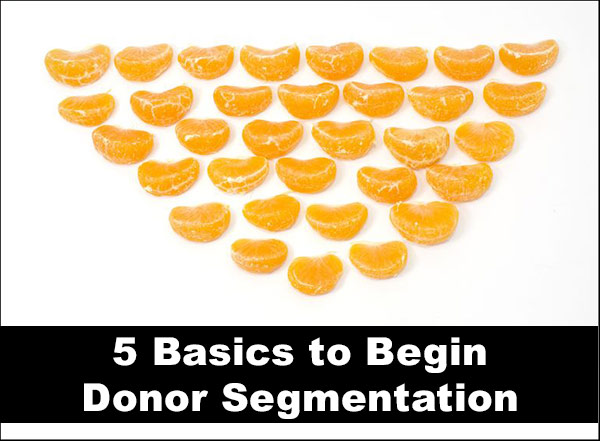Do you remember the saying, “Begin with the end in mind,” that great bit of advice given by the late Stephen Covey? In the business of growing nonprofits, how would this principle apply to one of our biggest assets, our donors?
Successful donor segmentation from the start is a key strategy to great donor communications and the beginning of the end of that nonprofit nightmare – donor attrition.
Beginning with the end in mind, it’s critical to understand the steps needed to boost our donor’s engagement, earn their loyalty, and keep them actively supporting our cause. There are no secrets here; fundraising experts agree nothing can beat targeted, personal communication with your donors.
Being at the helm of a fledgling nonprofit can be a heady experience, equal parts exhausting and exhilarating, and it’s easy to cut corners on something as seemingly minor as donor segmentation. But the information gained from segmentation is critical if your charity is to build engaged donor relationships, leading to repeat donations and create a following of raving fans.

What is donor segmentation?
To deliver on donor expectations, you’ll need to know who you’re talking to. Enter the donor database, which represents living, breathing individuals with specific needs, expectations and passions. If your database is one mass of people who get the same stock communication via one communication channel, you’re leaving donors unsatisfied and wasting precious resources.
The secret of quality communication with your supporters is the process of donor segmentation: categorizing information by basic criteria such as age, location, likes, dislikes, preferred form of giving, and favored form of communication, etc. provides a general picture of your donors. Your nonprofit can then use that information to personalize every contact and build a relationship with each individual.
What does segmentation accomplish?
With donor segments, you can employ more specific, personalized communication methods. The buzz word here is “personalized.” People will respond better to communication that engages them directly. Donor attrition is an industry-wide problem; forming a relationship with your existing donors is much easier and cheaper than finding new ones.
Creating a solid foundation of donor information doesn’t just happen, it takes time and planning. Before your supporter pool gets too big, start narrowing the information gap by keeping careful records of your donors and past contacts with them.
Five things you should know about your donors:
With a small group of donors, collecting information is relatively easy. It’s the commitment that counts. If you want to develop your donor communications to support retention, make loyal fans and increase income, you’ll need to do all you can to segment your list. Start with these basic criteria for a foundation.
- Which of the four main generational profiles does your donor fit into? There are distinct preferences among donors of each generation (Matures (Born before 1945), Baby Boomers (Born between 1946 and 1964), Generation Xers (Born between 1965 and 1980)) and Generation Ys or Millennials (born after 1980)) and these carry across the board from preferred communication platforms to favored giving channels and also adjust every year.My Millennial cousin – always ready to donate to a good cause – uses his credit card and mobile. My grandmother, on the other hand, wouldn’t dream of anything less than a check, properly signed and mailed. (More about generational giving on Blackbaud.)
- How often should donors receive material and communications from your nonprofit? Industry mavens can’t agree on just how often we should be contacting our donors – from four times a year to 12 times a year. The ideal number might differ from organization to organization and from donor to donor. In general, supporters will appreciate a donor-driven, story-focused newsletter generated several times a year.
- How do your donors like to hear from you? For some, email is the answer, others prefer social media and some folks still value direct mail or a friendly phone call. Whatever the preferred form of communication, one might not be enough. An in-person meeting can be followed up with a phone call; mix it up as needed to fit your donor’s expectations. Knowing the preferred communication methods of your supporters, through donor segmentation, saves time and money and improves donor service.
- What type of information do your donors want from your organization? What can you tell them that will boost donor engagement? Not every communication a donor receives should be an “ask,” your nonprofit can bring supporters up to date about community impact, news stories and other topics such as upcoming events. Donors also appreciate invitations to engage with the nonprofit, not only straight solicitations.
- How would your donors like to support your cause – what are their favorite giving channels and how much and how often do they give? People have different preferences, methods that they are used to and feel comfortable with, ranging from checks through the mail, online with a credit card, gifts by phone or even cash donations. Your donors’ giving frequency and amount might influence how often you send out communication to them. Don’t assume what your donors like – ask what their preferences and accommodate them.
Collecting this basic information for donor segmentation is a starting point for better donor relationships. As your organization grows and budget permits, a CRM (Contact Relationship Management) system will track a broader range of information, allowing detailed analysis.
A donor isn’t only an entry in a database. Keep in touch with your donors and thank them deeply and sincerely for every contribution. Let your supporters know they’re appreciated, how they are making the world a better place. Show your donors the loyalty you want them to show you. (More interesting facts about giving as seen in the Huffington Post.)
